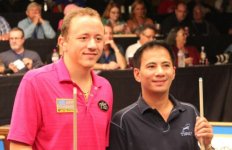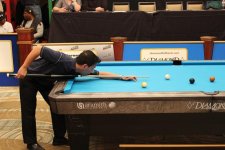US Open Showing
Congratulations Bob for a great showing and setting a strong example.
Well Done.
Congratulations Bob for a great showing and setting a strong example.
Well Done.
Very helpful shot and not very difficult when close to the pocket. I first seen and learned this shot from John Schmidt. Very good to know





Is it the same shot that shane plays here in 6:40? http://www.youtube.com/watch?v=tn3TdBJb8Q8
Ditto! Way to represent, dude!
Here's a demo of the type of shot Bob mentioned:
Other related examples can be found on the after-collision masse shot resource page.
Regards,
Dave
Good questions. I don't know the answer to the first, but I think it only becomes a foul if it's obvious in real time - unless they outlaw masses entirely....is it possible to hit a masse and strike the CB only once? If not, at what point does it become a foul?
It looks like Tom fouls the CB with this shot (watching the super slow motion -- he hits it more than once).
It is really hard to tell from that video. The camera line of sight needs to be near the tangent to the contact point of tip-to-ball. The cue stick could be simple rotating off the back of the ball.... It looks like Tom fouls the CB with this shot (watching the super slow motion -- he hits it more than once)....
I agree on both counts.It is really hard to tell from that video. The camera line of sight needs to be near the tangent to the contact point of tip-to-ball. The cue stick could be simple rotating off the back of the ball.Dave:Here's a demo of the type of shot Bob mentioned:
Other related examples can be found on the after-collision masse shot resource page.
It looks like Tom fouls the CB with this shot (watching the super slow motion -- he hits it more than once).
My question is -- is it possible to hit a masse and strike the CB only once? If not, at what point does it become a foul?
I agree with Pat. As with miscues, double hits on masse shots must be clear with an unaided eye to be able to call a foul.